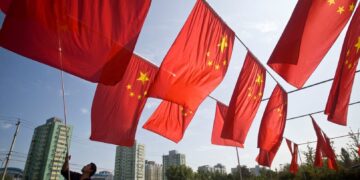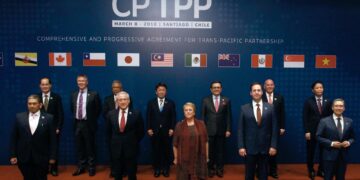The Obama administration’s China policy approach is starting to take shape. So far, the word “pragmatic” comes to mind.
The administration has shown pragmatism in several ways. In February, Secretary of State Hillary Clinton visited Beijing, where she positioned human rights issues as no more important than security and economic issues in the relationship. In the Treasury Department’s April report on exchange rates, the need for cooperation on global economic recovery trumped the pointless citing of China as a currency “manipulator.” And President Obama nominated Republican moderate and Utah Governor Jon Huntsman, who has a strong background in business and China trade policy, as ambassador to Beijing.
The next signal of Obama’s China trade policy will come in the decision on whether to apply punitive duties on low-end tire imports from China, as the United Auto Workers wants. If the administration lets this case go forward this summer, we can expect many more such cases and growing trade frictions.
Talk is cheap, effective dialogue is priceless
The business community is watching the development of a new bilateral dialogue structure to see if it will effectively address commercial issues. The first Strategic and Economic Dialogue (S&ED) will convene in Washington, DC, for two days during the last week of July. Clinton will lead the strategic side of the discussions opposite China’s top foreign policy official, State Councilor Dai Bingguo; Treasury Secretary Timothy Geithner will lead the economic discussions with Vice Premier Wang Qishan.
The success of the dialogue over time will depend upon interagency coordination and participation—on both sides. Three vice premiers handle roughly equal shares of China’s economic portfolio and the bureaucracies that line up underneath. On the US side, climate change and investment policies are just two examples of issues that cut across departments. Movement on the issues requires work from more than just the lead agencies involved.
Agenda crowding is also a concern. Global economic recovery and financial architecture discussions will likely dominate the “E” side of this first S&ED. Will there be room to also address commercial policy issues?
The Joint Commission on Commerce and Trade (JCCT) may be able to take on some of these commercial issues, adding a forward-looking policy component to the traditional (and necessary) negotiations over specific trade issues and disputes. Commerce Secretary Gary Locke and US Trade Representative Ronald Kirk bring a fresh opportunity to enhance the JCCT when it convenes for the first time under their leadership in late October.
Expanded engagement is important because the issues are many. As always, there is no shortage of industry-specific issues, but the growing concern is over systemic trends that could place a ceiling on foreign participation in China’s economy. China’s policies to promote “national economic security” and “indigenous innovation” are at the core of the concerns of US companies’ China-based executives.
There is no doubt that China’s World Trade Organization (WTO) entry eight years ago has reduced many market access barriers. American companies exported $72 billion in goods and services to China last year. US majority-owned affiliates in China racked up an estimated $63 billion in sales in 2006, the latest year of available data. Some of this “made in China, sold in China” revenue incorporates exports from the United States, but it is clear that China operations are now a significant part of global business health for many American companies and directly or indirectly support the job base in the United States.
Two kinds of champions
But the question is, where do China’s reforms go from here? National champions? Apparently. Market-based reform champions? Not so clear.
The reforms that China is moving ahead with—healthcare and technological innovation, for example—address pressing domestic priorities but are not designed to push China further toward an open market economy. This trend comes when it is already clear that the three regulatory regimes that matter globally are those of the United States, European Union, and China—whether for emissions trading, safety standards, merger reviews, or transfer pricing. Moves by China to strengthen domestic preferences are potentially more troublesome for foreign companies now that China has become such a significant market.
The leverage of China’s WTO entry terms to produce market openings is gone, of course. US credibility on economic and financial policy advice is low in China, as it is elsewhere. Buy American policies and market restrictions imposed on the disposal of General Motors’ Opel unit in Europe undermine prescriptions to China to limit government-mandated protections for domestic industry.
Public sentiment in China can’t be ignored, either. The media and public support a harder-nosed, protective approach to the market—a feedback loop has been built on the continually reinforced premise that China and Chinese companies are being treated unfairly overseas, while foreign companies are welcomed and treated as privileged guests with extra incentives and support. Though China’s central and local officials do not contend with electoral politics, the scrutiny of China’s netizens places immense pressure on the government—and is a massive disincentive to showing any “weakness.”
The bilateral discussion needs to be recast in this environment. The Obama administration will need to put parallel issues on the table: Chinese concerns about receptivity in the United States and the “level playing field” concerns of US companies operating in China. Investment policies and M&A approvals in the United States and China. Buy American vs. Buy China procurement policies. Competition policy. The government role in innovation and technology standards. Food and product safety. Most of the key issues can be addressed in this way.
In addition, US government and private sector advocacy should leverage the main lesson of the global economic downturn for China’s leadership: the need to reduce reliance on overseas markets for domestic economic well-being. We should tie our “wants” to this need. Continued market reforms and openings, particularly in the services sector, support Beijing’s priority of (finally?) making structural changes to increase the domestic demand component of gross domestic product. As export-driven employment growth evaporates, foreign investment supports job-creation in domestic industry development. China should encourage employment-expanding foreign investment, not curtail it.
Most important, US negotiators need to recognize that the Wall Street financial implosion and Washington policy response have put US market-based credibility in a hole. The US economy will return to strength (and probably faster than the voices of vindication in China realize), but we need to be humble while also being firm on principles and the ultimate goal—a relationship that benefits both economies equally.
Even under this approach, breakthroughs will be hard to come by. But the “Fix China” camp in Washington and elsewhere should be aware that the days of dictation are over, and a new approach is needed.
[author]John Frisbie is president of the US-China Business Council.[/author]






























